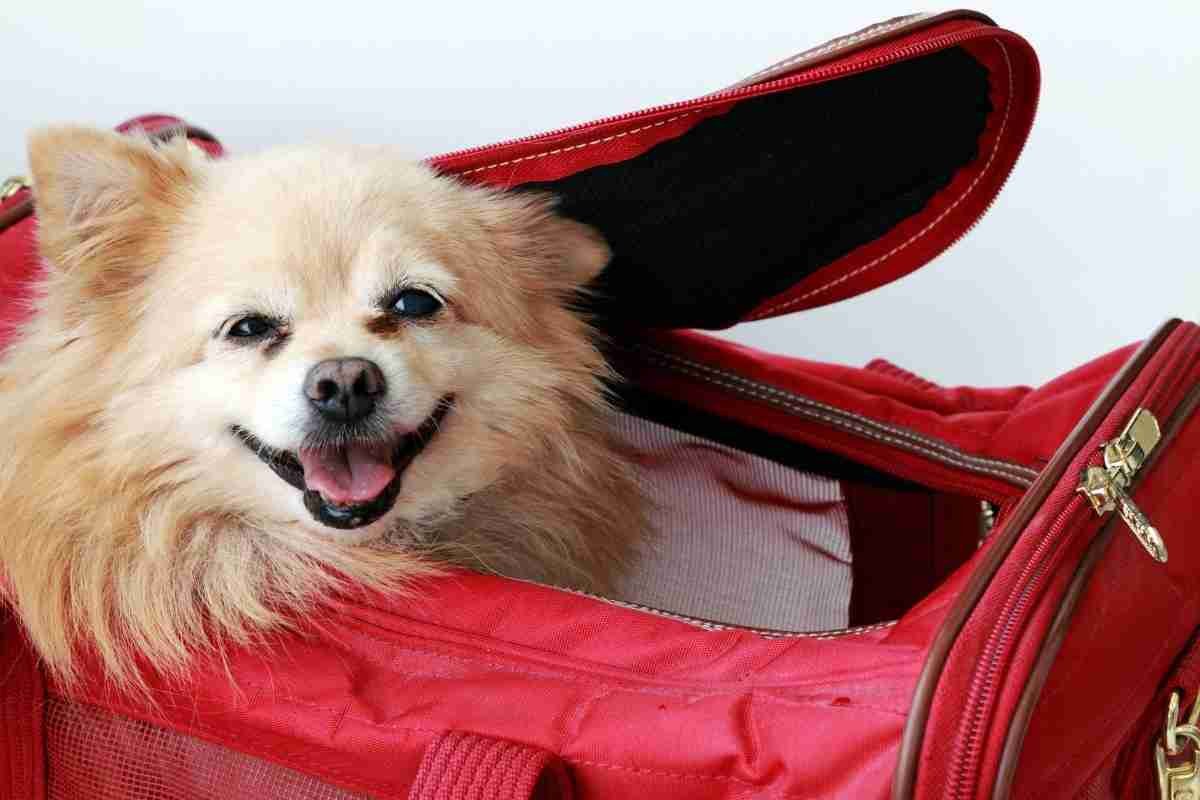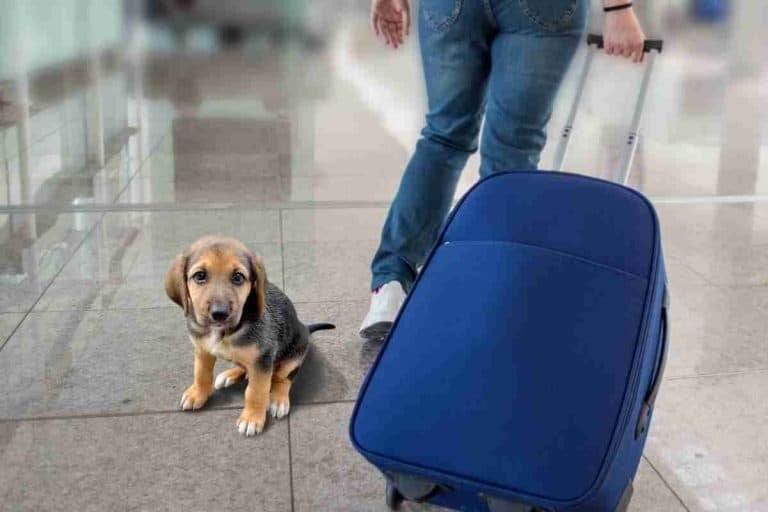What Happens If Your Dog Barks on a Plane? Airline Rules, Risks, and How to Handle It
Last Updated on August 20, 2025
What happens if your dog barks on a plane? Cabin crews treat persistent barking as a behavior and safety issue. They start with a request to quiet and secure the carrier. Continued noise can prompt seat moves, written warnings, or post‑flight restrictions. Knowing airline rules, risks, and how to handle it helps owners prevent escalation.
Readers will find clear guidance on in‑cabin versus cargo rules, common crew responses, and health concerns that drive barking. The sections outline preflight preparation, proven in‑flight calming tactics, and steps to document incidents if they occur. Special cases—service animals, breed limits, and international requirements—receive practical, plain‑language summaries. Handlers leave with a concise checklist to reduce disruptions and manage them confidently if they arise.
What Happens If Your Dog Barks on a Plane? Airline Rules, Risks, and How to Handle It
What happens on board when your dog starts barking
When a dog begins to bark in flight, the cabin environment changes quickly. Flight attendants assess safety, passenger comfort, and whether the sound signals distress or normal vocalization. Crew members ask the owner to quiet the dog first, often offering a seat relocation if space allows. If barking persists, crew will warn the owner about policy and possible escalation. Persistent noise that disrupts safety briefings, alarms, or other passengers can trigger stricter measures, including a formal incident report.
Owners should prepare documentation and carrier proofs ahead of boarding. Airlines vary on in-cabin pet rules and noise tolerance, so crew decisions balance airline policy with federal aviation safety guidelines. As mentioned earlier, some situations lead to preflight refusals; others unfold midflight and require different steps. For practical calming tips and how to prevent whining and barking before lift-off, refer to this guide on dog whining on plane. Passengers who notice a barking dog can politely alert crew rather than confront the owner. A calm, documented approach reduces conflict and speeds resolution.
Typical flight crew responses and escalation steps
Crew trains to manage disruptions while maintaining safety and calm. The first response is verbal: crew asks the owner to address the dog. They may suggest immediate actions—placing the dog back in its carrier, offering water, or moving the carrier under the seat properly. If the dog shows signs of distress, crew assess for medical issues and may request a vet check at the next stop.
If noise continues, crew follow escalation steps. They document the disturbance, issue warnings, and may involve a purser or captain for a policy decision. In rare cases, the captain can request the dog be restrained differently, require relocation, or, upon landing, refuse further transport. Crew can also refuse carriage preflight if they judge the dog unfit to fly. For clarity on in-cabin allowances and airline pet policies, see the list of airlines that allow dogs in cabin. Documentation of crew actions creates a record for the owner and airline, which matters for refunds or complaints.
Passenger reactions, complaints, and seating or relocation options
Passengers react differently to a barking dog—some tolerate it, others file complaints. Flight attendants collect complaint details, seat numbers, and descriptions. If adjacent seats exist, crew may offer relocation to a different row. Relocation depends on seat availability and safety regulations, such as exit row restrictions. Crew will not move passengers in ways that violate policy or compromise safety.
Complaints often lead to written reports and sometimes follow-up by the airline. Passengers who feel threatened or have health issues, like severe allergies, receive priority for relocation. When a barking dog occupies an under-seat carrier, crew may request the owner secure the carrier better or swap to a seat with more space. For guidance on which breeds fit under airplane seats, consult dog breeds that fit under airplane seat. Passengers should remain calm, use crew channels to resolve issues, and avoid confronting owners directly.
Differences between preflight refusals and midflight actions
Preflight refusals and midflight actions address different risks. Preflight refusals occur when staff determine a dog poses a health or safety risk before departure. Common reasons include visible illness, aggressive behavior, or failure to meet carrier size rules. Refusal prevents boarding and can lead to ticket denial or rebooking. Policies for preflight denial vary widely among carriers.
Midflight actions respond to emergent issues after takeoff. These steps prioritize immediate safety and passenger welfare. Crew can issue warnings, require behavioral correction, or document the incident for post-flight action. Midflight measures seldom result in removal during flight unless a dog endangers others physically. After landing, the airline may refuse future carriage or require a certificate of fitness. For owners reacting to travel anxiety concerns that cause barking, explore natural remedies and preparation tips in 9 natural ways to remedy your dog’s travel anxiety. Owners should always check carrier rules and prepare behavior plans to avoid both preflight refusals and midflight escalations.
How airline policies treat noisy pets
Airlines treat noisy pets as potential safety and comfort hazards. Carriers write rules that require owners to keep animals quiet and under control. Repeated barking or howling can trigger staff intervention, ranging from warnings to refusing boarding. Policies differ by airline and by whether the animal travels in-cabin, in checked baggage, or in cargo. Some carriers classify noise under “behavior” and require documentation proving an animal will not be disruptive. Others list disruptive behavior as a reason to deny carriage at check-in or at the gate.
Airlines also weigh health and welfare. A dog that barks because of distress or illness can prompt a veterinary check or refusal to transport. Training and acclimation to the carrier influence staff decisions during boarding. Owners should review specific carrier rules before travel and prepare evidence of training or prior calm flights when necessary. For a practical guide to which airlines accept in-cabin pets and their baseline rules, consult resources like airlines that allow cats in cabin. Confirm policy with the airline before booking and prepare to demonstrate the dog’s fitness for travel.
In-cabin vs cargo rules and size/weight limits that affect enforcement
Airlines enforce different standards for in-cabin and cargo travel. In-cabin rules typically limit pets by combined carrier-plus-pet weight and carrier dimensions that must fit under the seat. Carriers require soft- or hard-sided carriers meeting exact measurements. If a dog barks but remains inside an approved carrier, staff assess whether the noise disturbs other passengers. Size limits directly affect enforcement: larger dogs often must travel as cargo or on specialized pet programs, where different handling and noise expectations apply.
Cargo rules add safety conditions. Many airlines ban brachycephalic (snub-nosed) breeds from cargo on hot days, due to breathing risks. Cargo kennels must meet International Air Transport Association standards. Owners must check whether a breed’s size or respiratory traits change where the animal can fly. For lists of small breeds that usually fit under an airplane seat, see dog breeds that fit under airplane seat. If a dog’s size forces cargo travel, owners should prepare for stricter scrutiny and potentially different remedies if barking occurs.
How major carriers commonly enforce behavior rules (examples)
Major carriers grant cabin crew authority to address disruptive animals. Common enforcement steps include issuing a warning, requiring additional containment (zip ties, carrier repositioning), or asking the owner to remove the animal from the aircraft. If barking persists, staff may deny boarding, require the owner to rebook the pet on a later flight, or place the animal in cargo if regulations permit. Airlines also reserve the right to refuse transport at check-in if the dog shows aggressive or uncontrollable behavior.
Airlines usually record incidents in passenger records. Repeated disturbances can lead to future travel restrictions or requirements for professional training proof. Staff document reasons for denial, such as continuous barking or attempts to escape the carrier. Owners can reduce the chance of enforcement by using preflight training, acclimation sessions, and calming tactics. For context on carrier handling of animals placed in cargo, review policies like those summarized at airlines that allow dogs in the cargo.
Booking, fees, and documentation that influence whether a dog is accepted
Booking procedures, fees, and paperwork shape acceptance more than behavior alone. Most airlines require a pet reservation because carriers limit the number of animals per flight. Standard fees apply per direction for in-cabin pets; cargo shipments incur crate costs and handling fees. Airlines require up-to-date vaccination records and, for international travel, a health certificate issued within a specific time window. Missing or incomplete documentation can lead to last-minute refusal at check-in.
Service and emotional support animal rules changed recently; airlines now require documentation specific to service animals and have stricter criteria for emotional support animals. International flights also demand import permits, rabies certificates, and sometimes quarantine arrangements. Owners should book the pet space early, pay required fees, and upload documents before travel when possible. For practical guidance on which dogs typically meet carriers’ acceptance criteria, see dogs you can take on a plane. Confirm all requirements directly with the airline and arrive at the airport well ahead of check-in.
Health and safety concerns tied to excessive barking

Stress, ear‑pressure pain, and other physiological risks for the dog
Excessive barking signals heightened stress. The dog shows raised heart rate, rapid breathing, drooling, or vomiting. Long episodes of vocalizing can exhaust the animal and dehydrate it. Rapid cabin pressure changes during ascent and descent can cause ear‑pressure pain. Dogs with respiratory infections or blocked Eustachian tubes face higher risk of barotrauma. Brachycephalic breeds often struggle more with breathing and heat regulation. Owners should monitor for trembling, repeated pawing at the head, or sudden silence—signs of acute pain. For technical details on ear effects during flight, see does flying hurt dogs’ ears?
Safety risks to people and pets when attempting to silence a dog
Attempts to quiet a barking dog can escalate danger. Grabbing a carrier or forcing the muzzle may provoke bites. Sudden movements in a crowded aisle risk tripping attendants or passengers. Pulling a restless dog from its carrier can damage restraints or harm other pets nearby. Commercial crews trained in safety prefer containment and calm handling. Passive measures—comforting from a distance, placing a familiar blanket over the carrier, or asking crew for help—reduce risk without physical confrontation.
Guidance on sedation: when it’s unsafe and when to consult a vet
Sedation can compound in‑flight risks. Many sedatives depress breathing and affect temperature control. Airlines and vets often advise against routine sedation, especially for brachycephalic or very young/old dogs. Consult a veterinarian well before travel if anxiety is severe. A vet can recommend behavior modification, prescriptive anxiolytics with known dosing, or non‑pharmaceutical options like pheromone collars. Always verify airline policy and obtain written medical guidance before giving any medication.
Preflight preparation to minimize barking chances
Owners who prepare carefully reduce the odds of in-flight barking and stress. Start weeks before travel and build predictable routines. Focus on three practical areas: training that simulates travel, conditioning the carrier, and timing exercise, food, and bathroom breaks.
Training and desensitization exercises that simulate travel conditions
Create short, repeatable sessions that mimic airport and aircraft stimuli. Play recordings of terminal and cabin noise at low volume, then slowly raise it over days. Practice being handled—leash fitting, seatbelt clips, and brief crating with the door closed for increasing intervals. Use reward-based training: mark calm behavior and reward with small treats or a favorite toy. Add short public outings near busy places to habituate the dog to crowds and movement. Gradual exposure beats one-off intense sessions.
Choosing and conditioning the right carrier or kennel
Select a carrier sized for comfortable turning and lying down that meets the airline’s basic fit requirements. For in-cabin travel, soft-sided carriers often allow airflow and a snug fit under the seat. Condition the dog by leaving the carrier open at home, feeding meals inside, and placing familiar-smelling bedding and a secure chew toy. Gradual crate training reduces panic; start with minutes, then hours. For extra tips on travel gear and acclimation, see essential dog travel tips and gear.
Exercise, feeding, and restroom timing before travel
Schedule a vigorous walk or play session 30–60 minutes before check-in to expend excess energy. Offer a light meal 3–4 hours before departure to avoid nausea. Provide water until about an hour before travel, then limit intake to reduce accidents. Take the dog to a designated relief area immediately before security or boarding. Consider a pheromone spray on bedding and consult a veterinarian about short-term anxiety aids if prior measures fail. Book a practice trip when possible to test timing and the dog’s response.
In‑flight tactics to calm a barking dog

Strong, calm handling reduces barking quickly. First, the handler should assess why the dog barks: fear, motion, confinement, or attention-seeking. If anxiety drives the noise, move to a brief calming routine: lower voice, slow pats, and controlled breathing. Keep the carrier steady under the seat and avoid sudden movements that spike stress. Offer a lick mat or long-lasting chew only if the dog accepts it reliably; novel items may increase agitation.
If the dog persists, deploy a two-step approach: interrupt, then redirect. A neutral interruption (short clasp of the carrier or gentle cover) breaks the vocal pattern. Immediately follow with a low-effort reward—a small treat or soft praise—when the dog settles. Avoid high-energy consolation that rewards barking. Cabin crew can assist; inform them early so they understand the situation and can act if necessary. For more tips on vocal dogs in flight, see how to handle dog whining on a plane.
Handlers should pack a compact calming kit before travel. It should include treats, a familiar blanket, and a chew. If the dog shows signs of severe distress, contact crew right away. Airlines can enforce rules that may require relocating or deplaning an animal that repeatedly disrupts the cabin.
Calming aids and tools: wraps, pheromones, treats, and distraction toys
Calming aids reduce arousal and give the handler tools to manage noise. Anxiety wraps such as a Thundershirt apply gentle pressure and calm many dogs within minutes. Pheromone products—spray or collar—mimic maternal scents and lower stress for some animals. Apply pheromone spray to bedding or inside the carrier a half hour before boarding.
Choose treats labeled for calming and check ingredients for L-theanine, chamomile, or tryptophan. Use tiny, high-value bites to avoid stomach upset. Avoid new foods immediately before flying. For distraction, select a proven, non-messy slow chew or a compact puzzle toy. Test every product at home first to ensure the dog tolerates it.
Handlers should not improvise sedatives without veterinary guidance. Over-the-counter or prescription sedation can affect breathing or balance at altitude. For natural options and anxiety remedies tested for travel, consult natural ways to remedy a dog’s travel anxiety before boarding.
Practical handling tips: positioning, cues, and quieting commands
Positioning the carrier correctly changes a dog’s perception of safety. Place the carrier under the seat where the dog can sense the handler’s feet. If the dog prefers visibility, choose a seat with more legroom so the handler can gently touch the carrier. Avoid shifting the carrier during taxi, takeoff, and landing.
Train two concise cues for flight: a calm recall and a quiet command. The quiet cue should follow interruption consistently. Begin reinforcement on the ground: interrupt, cue, then treat when the dog stops barking. Gradually practice inside a carrier, then in a car, and finally in noisy environments to generalize the behavior.
Use timing to control reactions. Give a walk and chance to relieve itself an hour before boarding. Keep the dog on a leash while boarding and avoid crowded aisles where strangers may startle it. Bring a soft, familiar blanket and place it over the carrier to reduce visual triggers. For broader travel gear and practical packing suggestions, handlers can review essential dog travel tips and gear.
How to work with crew members and politely inform nearby passengers
Clear, polite communication prevents escalation. Notify the gate agent and flight attendants about the dog at check-in. A brief, factual statement—“This dog is anxious and may vocalize”—sets expectations. Crew can note passenger seating or advise alternatives. If repeated barking becomes an issue, the crew knows why the handler already prepared.
When addressing nearby passengers, keep messages short and courteous. A simple, calm apology paired with a one-sentence explanation often diffuses tension. Offer practical mitigation: “If this becomes a problem, please let me or a crew member know.” Avoid lengthy justifications or defensive language.
If passengers complain, remain composed. Crew possess authority to manage seating changes or enforce airline pet policies. Handlers should have documentation handy—vaccinations and certifications—to prevent disputes. For etiquette and managing travel interactions with animals, handlers may find guidance in traveling with a dog by train: tips and tricks. Pack printed airline regulations and a compact apology card to hand quietly to affected passengers when needed.
If barking escalates: likely consequences and how to respond
Flight crews and fellow passengers expect pets to remain quiet. When a dog’s barking escalates, crews balance safety, comfort, and federal rules. Immediate responses range from gentle warnings to more significant interventions. Owners should prepare for swift action and possible documentation. The next subsections explain specific crew options, likely post-flight outcomes, and steps to build an appeal should an airline take formal action. Owners who travel with dogs regularly will find prevention easier after learning airline procedures and paperwork requirements. For broader preflight preparation and gear that reduces in-flight stress, consult essential dog travel tips and gear.
Possible crew actions: warnings, containment, or re‑routing to cargo
Crew members will first assess safety and disruption. They usually issue a verbal warning and ask the owner to calm the dog. If barking continues, flight attendants may require the pet to stay contained in its carrier under the seat. If the dog poses a safety risk or triggers medical issues for other passengers, the crew can request more drastic measures. In rare cases, the airline may deny carriage in the cabin and move the dog to cargo or involuntary offload the animal before takeoff. Policies differ by carrier, and some will cite breed, size, or behavior history when deciding. Owners can review each airline’s rules in advance; for example, carriers that accept animals in hold compartments vary by route and season. Learn which carriers accept animals in cargo through resources about airlines that allow dogs in the cargo.
Potential outcomes after the flight: denied boarding, refunds, or complaints
After landing, consequences depend on the incident’s severity and the airline’s policy. Outcomes range from a formal warning placed on the owner’s record to denial of future bookings. If flight crews deem the pet unsafe, the airline can refuse future carriage or require a temperament assessment before approving travel again. Refunds rarely occur for behavioral incidents, though partial compensation may appear if the airline changes itinerary or places the dog in an unsuitable environment. Passengers affected by a noisy dog may file complaints or request reimbursements, prompting airline investigations. Owners facing sanctions should review the carrier’s contract of carriage and submit timely appeals. Checking policies about cabin allowances can help predict a dispute’s likely outcome; see guidelines about airlines that allow large dogs in cabin for policy comparisons.
How to document the incident and appeal or dispute airline decisions
Effective documentation improves the chance of a successful appeal. Collect timestamps, boarding passes, seat numbers, and witness statements. Record short videos showing behavior before and during crew interventions. Request a written incident report from the crew before leaving the airport. Keep vet records, recent training certificates, and proof of behavior programs handy. Submit a formal written appeal to the airline’s customer relations within the stated deadline. Attach all evidence and a clear timeline of events. If the airline rejects the appeal, escalate to the national aviation consumer protection body or a small-claims court, depending on local rules. For guidance on managing in-flight noise and calming strategies that reduce future incidents, review practical tips from resources on dog whining on plane. Start the appeal promptly to preserve rights and meeting windows set by most carriers.
Special cases that change what happens
When a dog barks on a plane, outcomes vary widely depending on special circumstances. Airlines treat regular pets, service animals, and emotional support animals differently. Local and international rules, breed limits, and airport policies also change what happens next. A dog that barks briefly and then calms usually prompts a polite request from crew. A dog that persists, lunges, or shows aggression can lead to removal, refused boarding, or quarantine depending on the route.
Documentation and prior notice often determine next steps. Advance notification and proper paperwork reduce the chance of a disruptive confrontation. Some carriers allow certain dogs in-cabin but require specific carrier sizes and behavior standards; others rebook or refuse pets that threaten safety. Owners should verify requirements well before travel. For a quick reference on which animals airlines commonly accept in-cabin, see dogs you can take on a plane.
When removal occurs, the airline documents the incident. That record affects future bookings and may trigger fees or bans. A calm de-escalation—removing the dog to a quiet area or offering water and a leash-friendly walk at a gate pet relief zone—often prevents escalation.
Service animals: legal protections and behavioral expectations
Service animals receive legal protections that differ from pet rules. In many jurisdictions, airlines recognize service animals as necessary aids. Those protections still require dogs to behave. If a service dog barks repeatedly or acts aggressively, the airline may remove the animal to protect passengers.
Airlines commonly request proof of training or documentation when service animals travel. Handlers must control the dog throughout boarding, flight, and deplaning. Crew members may ask for reasonable assurances that the animal will not disrupt the flight. Failure to comply can result in denied boarding or offloading at the gate.
When disputes arise, handlers can file complaints with the carrier or regulatory agency. Keeping certification, health records, and a recent behavior assessment together reduces friction. For guidance on carriers that permit larger in-cabin dogs and their likely expectations, see airlines that allow large dogs in cabin.
Emotional support animals and how recent policy changes affect them
Policies for emotional support animals changed significantly in recent years. Most major carriers now classify ESAs as pets rather than service animals. That reclassification removed many automatic protections. As pets, ESAs must follow each airline’s pet rules, fees, and carrier requirements.
Because ESAs travel as pets, barking becomes a standard pet behavior issue. Airlines apply their usual disruptive-pet procedures, which may include relocation to cargo, refusal to board, or additional documentation requests. International flights often impose stricter rules, including quarantine or import permits, for animals not recognized as trained service animals.
Owners should check individual airline pet policies well before booking. Understanding the carrier’s ESA stance prevents surprises at check-in. For examples of cabin pet rules and how carriers manage animal behavior, consult airlines that allow cats in cabin.
Breed restrictions, international travel rules, and airport pet‑area policies
Breed-specific rules and international requirements strongly affect what happens when a dog misbehaves on a flight. Many airlines restrict brachycephalic breeds because of breathing risks. Other carriers bar certain breeds due to perceived aggression. Countries also enforce import rules, vaccination deadlines, and quarantine periods that may force removal or surrender on arrival.
International flights add paperwork layers. Rabies certificates, export permits, and microchip information often determine whether an animal can enter a country. If a barking dog poses a public-health or quarantine risk, authorities may impose isolation or denial of entry.
Airport pet relief and holding areas differ by facility. Some airports offer secure, calming spaces; others provide only outdoor relief zones before security. Owners should identify pet areas during connections to reduce anxiety and barking. For specifics on airline policies for short-muzzled dogs and related restrictions, see airlines that allow snub-nosed dogs.
If travel involves special cases, double-check carrier rules and country entry requirements early. That step often prevents costly disruptions and ensures safer outcomes for both dog and passengers.
Quick preflight checklist and where to get help
Owners should complete key tasks well before arrival at the airport. Confirm airline rules, assemble paperwork, and prepare the dog to reduce barking risks. Follow a short preflight routine to check health clearance, carrier compliance, and calming practices. Keep contact numbers for the airline’s pet desk and the veterinarian handy. If concerns remain, consult professional trainers or legal resources listed below.
One‑page checklist to prepare your dog and paperwork before travel
- Health paperwork: Current vaccination records and a vet health certificate if the airline requires one.
- Carrier size and labeling: Carrier that fits airline dimensions and clearly labeled with contact details.
- Comfort items: A favorite blanket, absorbent pad, and a familiar-smelling toy to reduce stress.
- Feeding and exercise: Light meal 3–4 hours before travel and a brisk walk to expend energy.
- Backup plan: Contact list for emergency boarding or pet sitters at the destination.
Refer to Essential dog travel tips and gear for road trips for gear recommendations that also work for flights.
Questions to ask your airline and your veterinarian
Owners should confirm these specifics before booking. Ask the airline about cabin vs. cargo allowances, carrier specs, fees, and required documentation. Ask whether the airline enforces pet relief breaks during connections. From the veterinarian, request a fitness-for-travel note and discuss anxiety options. Also clarify whether sedation is safe; many airlines prohibit sedated pets. For airline policy examples, review airlines that allow dogs in the cargo.
Resources for training help, legal guidance, and airline pet policies
Use certified trainers for desensitization and crate training. Seek behaviorists for separation or noise anxiety programs. For legal questions about service animals or denied boarding, consult an attorney experienced in aviation or disability law. For calming strategies and non-drug remedies, see 9 natural ways to remedy your dog’s travel anxiety. If uncertainty persists, schedule a vet consult and contact the airline’s pet desk before travel.
Summary
This guide explains what happens if a dog barks on a plane and how airlines and crews typically respond. It covers the steps flight attendants take—from verbal requests and seating adjustments to documentation and potential refusal of carriage—and clarifies how policies differ by airline, cabin vs. cargo, and special cases like service animals and international travel.
It also addresses the health and safety risks behind excessive barking, preflight preparation to reduce the chance of vocalizing, and practical in‑flight calming tactics. Owners learn how to communicate with crew, handle complaints, and document incidents, along with when to consult a veterinarian about anxiety aids or medication.
Key Takeaways
- Know the rules: Review airline pet policies, size/weight limits, and booking requirements; expect warnings and documentation if barking disrupts the cabin.
- Prevent before you fly: Use desensitization, carrier conditioning, exercise, and smart feeding/water timing to reduce anxiety and vocalizing.
- Pack a calming kit: Bring a familiar blanket, proven chews, tiny high‑value treats, and optional pheromone products; avoid first‑time items on flight day.
- Use quieting techniques: Keep the carrier stable under the seat, interrupt and redirect, apply a light cover, and reinforce a trained “quiet” cue.
- Coordinate with crew: Proactively inform flight attendants, accept seating adjustments, and let crew handle complaints and relocations.
- Plan for escalation: Persistent barking can lead to incident reports, denied boarding, or future restrictions; document events and appeal promptly if needed.
FAQ
- What happens if a dog won’t stop barking on a plane? Crew issue verbal warnings, require stricter containment, and may relocate seats if available. If disruption continues, they document the incident and can deny cabin travel or future carriage after landing.
- How can owners prevent barking before a flight? Start carrier conditioning and noise desensitization weeks ahead, schedule exercise, and time a light meal and bathroom break. Bring familiar bedding and vetted calming aids to keep arousal low.
- How should a barking dog be calmed during the flight? Stabilize the carrier under the seat, lightly cover it to reduce visual triggers, and use an interrupt‑and‑quiet cue followed by tiny rewards when silence returns. Ask crew for help early if the dog struggles.
- Why do airlines take barking seriously? Repeated barking affects safety briefings, can mask alarms, and disturbs passengers, including those with allergies or health concerns. Policies prioritize safety, cabin comfort, and compliance with regulations.
- How safe is sedation for airline travel? Routine sedation is often discouraged because it can depress breathing and impair temperature regulation at altitude. Consult a veterinarian well before travel for appropriate options or non‑drug strategies, and confirm airline rules.







